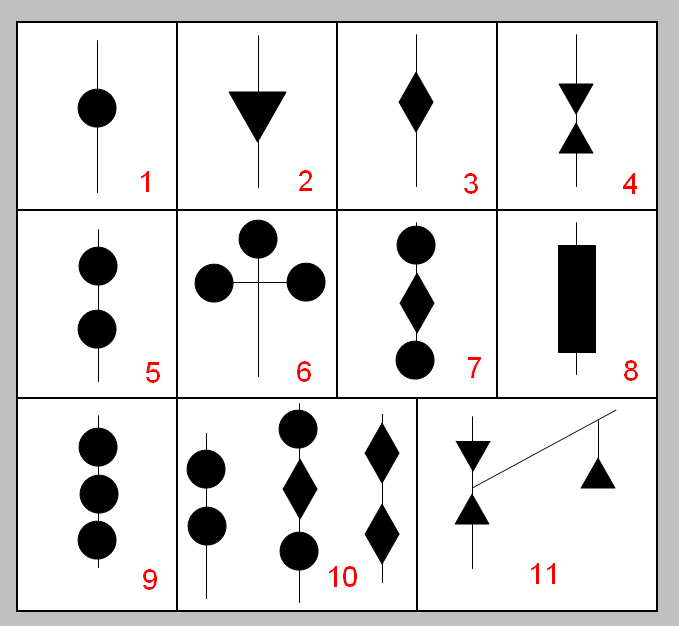Day Shape on:
[Wikipedia]
[Google]
[Amazon]
Day shapes are mast head signals visually indicating the status of a vessel to other vessels on navigable waters during daylight hours whether making-way, anchored, or aground. These signals consist of a set of simple geometric shapes—''ball'', ''cylinder'', ''cone'', and ''diamond''—that are displayed, hung from a mast, in a prescribed manner to indicate a vessel's operational status; some of these signals may be somewhat involved. The meanings of the shapes are defined by the  Day shapes are black in color and their sizes are determined by the ColRegs; for example, the size of the ball is not less than . The vertical distance between shapes is at least . Vessels of less than length may use shapes of smaller size commensurate with the size of the vessel. Day shapes of standard and reduced sizes are both commercially available. Day shapes are commonly constructed from a light weight frame covered with fabric and are designed to be collapsible for ease of storage.
Day shapes are designed to correspond to the various navigation lights required to be shown at night, and are required to be complied with by day from sunrise to sunset. The appropriate lights may also be displayed during the day at times of restricted visibility or other necessary circumstances. Vessels under 7 meters are generally not required to display day shapes even if they are required to display lights at night.
A square black flag displayed over the ball may be used as a distress signal.
Some of the most common signals are as follows:
Day shapes are black in color and their sizes are determined by the ColRegs; for example, the size of the ball is not less than . The vertical distance between shapes is at least . Vessels of less than length may use shapes of smaller size commensurate with the size of the vessel. Day shapes of standard and reduced sizes are both commercially available. Day shapes are commonly constructed from a light weight frame covered with fabric and are designed to be collapsible for ease of storage.
Day shapes are designed to correspond to the various navigation lights required to be shown at night, and are required to be complied with by day from sunrise to sunset. The appropriate lights may also be displayed during the day at times of restricted visibility or other necessary circumstances. Vessels under 7 meters are generally not required to display day shapes even if they are required to display lights at night.
A square black flag displayed over the ball may be used as a distress signal.
Some of the most common signals are as follows:
United States Coast Guard, Navigation Center, Navigation Rules On-Line
International Maritime Organization: COLREGS
International Maritime Organization Law of the sea Nonverbal communication {{Water-transport-stub
International Regulations for Preventing Collisions at Sea
The International Regulations for Preventing Collisions at Sea 1972 (COLREGs) are published by the International Maritime Organization (IMO) and set out, among other things, the "rules of the road" or navigation rules to be followed by ships a ...
(ColRegs).
See also
*International Maritime Organization
The International Maritime Organization (IMO, French: ''Organisation maritime internationale'') is a specialised agency of the United Nations responsible for regulating shipping. The IMO was established following agreement at a UN conference ...
* International Regulations for Preventing Collisions at Sea
The International Regulations for Preventing Collisions at Sea 1972 (COLREGs) are published by the International Maritime Organization (IMO) and set out, among other things, the "rules of the road" or navigation rules to be followed by ships a ...
* Marine navigation lights
* US Coast Guard
References
External links
United States Coast Guard, Navigation Center, Navigation Rules On-Line
International Maritime Organization: COLREGS
International Maritime Organization Law of the sea Nonverbal communication {{Water-transport-stub